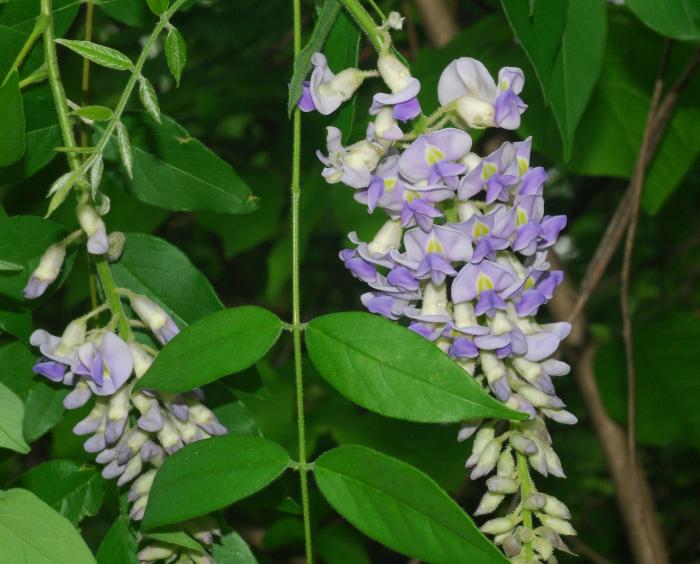Wisteria frutescens (L.) Poir.
American Wisteria

Native
CC = 4
CW = -3
MOC = 22
© SRTurner
Wisteria frutescens (L.) Poir.American Wisteria | |
 |
Native CC = 4 CW = -3 MOC = 22 |
© SRTurner |
|
Family - Fabaceae/Faboideae Habit - Rhizomatous perennial woody vine (liana). Stem - To 15 m or more, high-climbing, strongly woody, stout, twining in counterclockwise fashion (as viewed from the growing tip), unarmed, glabrous or nearly so, tan to brown.
Leaves - Alternate, odd-pinnately compound, petiolate, with 7-13 leaflets. Stipules 1-3 mm long, linear, shed early; stipels similar to the stipules, mostly shed early. Leaflets 4-8 cm long, ovate to elliptic, rounded to broadly angled at the base, sharply pointed, the margins entire, the upper surface glabrous, the lower surface and margins hairy, the terminal leaflet with the stalk 10-25 mm long, the lateral leaflets very short-stalked.
Inflorescence - Terminal racemes, showy and with numerous flowers, to 25 cm long, pendent, the bracts 4-14 mm long, lanceolate, shed early. Flower stalks to 14 mm, densely pubescent with stiff hairs and also club-shaped, stalked glands.
Flowers - Calyces 6-9 mm long, white to pale green, densely pubescent with stiff, mostly loosely ascending hairs and also scattered club-shaped, stalked glands. Corollas papilionaceous, glabrous, 15-20 mm long, bluish purple, often with a white and/or light yellow region toward the base, the banner with the expanded portion bent backward near midpoint. Stamens 10, 9 of the filaments fused and 1 filament free, the anthers small, attached at or near the base. Ovary 10-12 mm long, linear, short-stalked, encircled by a ringed nectar gland below the midpoint, glabrous, the style glabrous, the stigma terminal.
Fruits - Fruits 7-10 cm long, glabrous, with 4-8 seeds. Seeds 11-14 mm long, 7-8 mm wide, kidney-shaped or broadly elliptic, sometimes more or less oblong in outline, only slightly flattened.
Flowering - April - May. Habitat - Bottomland forests, streambanks, bases of bluffs, former homesteads. Origin - Native to the U.S. Lookalikes - Wisteria sinensis. Other info. - This plant's large, showy inflorescences are hard to miss, and it has often been cultivated as an ornamental. Wild occurrences have been found in scattered counties in Missouri, mostly toward the east side of the state. Its native range is mostly within the southeastern quadrant of the continental U.S. Over time the size and weight of the vegetation can become substantial, so stout trellises must be used for support. The flowers are strongly scented, and floral extracts have been used as a fragrance in soaps, incense, etc. The flowers have been eaten, but the seeds are somewhat toxic and should not be consumed. Photographs taken at Route 66 State Park, St. Louis County, MO, 5-10-2015 (SRTurner). Fruit photo 9-13-2020 (KBildner). |